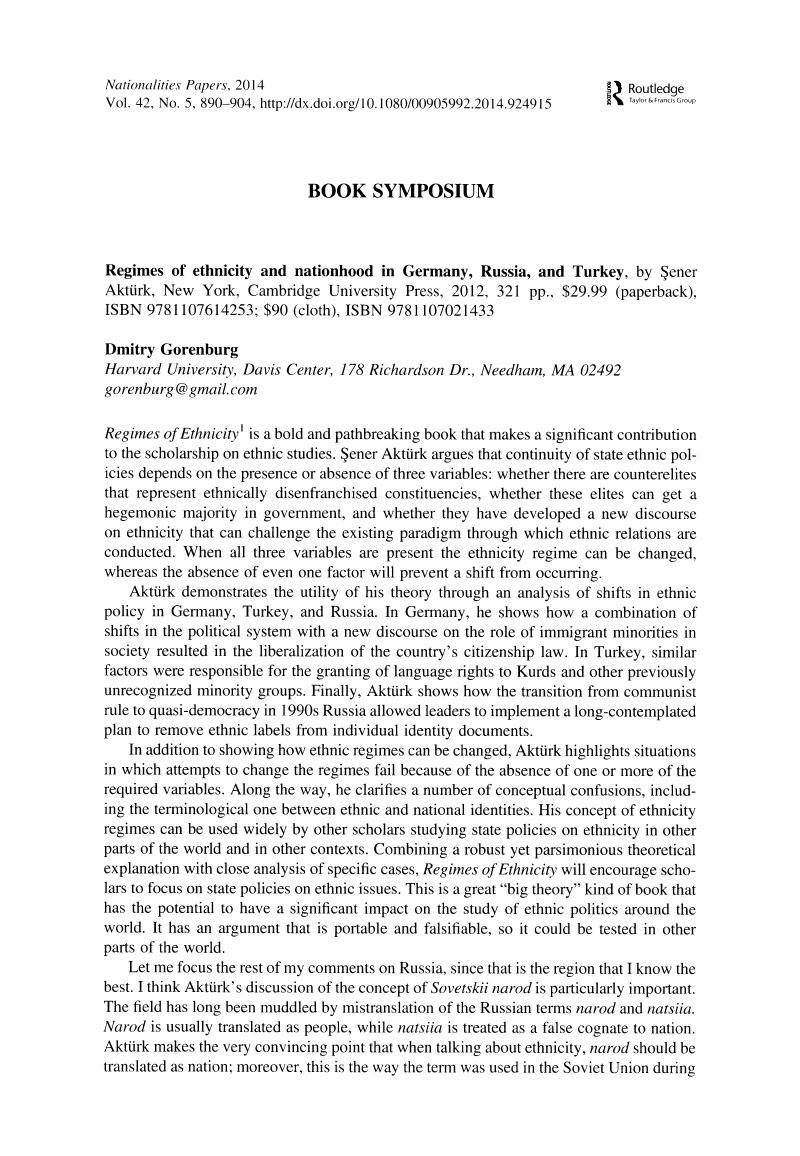No CrossRef data available.
Article contents
Regimes of ethnicity and nationhood in Germany, Russia, and Turkey, by Şener Aktürk, New York, Cambridge University Press, 2012, 321 pp., $29.99 (paperback), ISBN 9781107614253; $90 (cloth), ISBN 9781107021433
Published online by Cambridge University Press: 20 November 2018
Abstract
An abstract is not available for this content so a preview has been provided. Please use the Get access link above for information on how to access this content.

- Type
- Book Symposium
- Information
- Copyright
- Copyright © 2014 Association for the Study of Nationalities
References
References
Acemoglu, Daron, and Robinson, James A.
2006. Economic Origins of Dictatorship and Democracy:
New York: Cambridge University Press.Google Scholar
Cederman, Lars-Erik, Wimmer, Andreas, and Min, Brian. 2010. “Why Do Ethnic Groups Rebel?: New Data and Analysis.” World Politics
62 (1): 87–119.Google Scholar
McAdam, Doug, Tarrow, Sidney, and Tilly, Charles. 2001. Dynamics of Contention. New York: Cambridge University Press.Google Scholar
Tezcür, Güneş Murat, and Gürses, Mehmet. 2014. “Who Governs? Ethnic and Regional Roots of Political Power in Turkey.” Paper presented at the 19th annual world convention of the Association for the Study of Nationalities, New York.Google Scholar
Ülker, Erol. 2008. “Assimilation, Security and Geographical Nationalization in Interwar Turkey: The Settlement Law of 1934.” European Journal of Turkish Studies. Accessed December 11, 2008, Connection on November 18, 2013. http://ejts.revues.org/2123
Google Scholar
Üngör, Uğur Ümit. 2012. The Making of Modern Turkey: Nation and State in Eastern Anatolia. New York: Oxford University Press.Google Scholar
Wimmer, Andreas. 2013. Waves of War: Nationalism, State Formation, and Ethnic Exclusion in the Modern World. New York: Cambridge University Press.Google Scholar
Yayman, Hüseyin. 2011. şark Meselesinden Demokratik Açilima: Türkiye'nin Kürt Sorunu Hafizasi. Ankara: SETA Yayinlari.Google Scholar
Yeğen, Mesut. 1996. “The Turkish State Discourse and the Exclusion of Kurdish Identity.” Middle Eastern Studies
32 (2): 216–229.Google Scholar
References
Aktürk, şener. 2009. “Persistence of the Islamic Millet as an Ottoman Legacy: Mono-Religious and Anti-Ethnic Definition of Turkish Nationhood.” Middle Eastern Studies
45 (6): 893–909.Google Scholar
Aktürk, şener. 2010. “Passport Identification and Nation-Building in Post-Soviet Russia.” Post-Soviet Affairs
26 (4): 314–341.Google Scholar
Gorenburg, Dmitry P.
2003. Minority Ethnic Mobilization in the Russian Federation. New York: Cambridge University Press.Google Scholar
Miller, John H.
1977. “Cadres Policy in Nationality Areas: Recruitment of CPSU First and Second Secretaries in Non-Russian Republics of the USSR.” Europe-Asia Studies
29 (1): 3–36.Google Scholar
Ülker, Erol. 2008a. “Assimilation of the Muslim Communities in the First Decade of the Turkish Republic (1923-1934).” European Journal of Turkish Studies. Accessed May 29, 2014. http://ejts.revues.org/822
Google Scholar




